|
University of Chicago, IL
Oak Ridge, TN
Los Alamos, NM
Trinity Site, NM
Historic Manhattan
Project Sites
Oak Ridge, TN -
July 12, 2012
During WWII Oak Ridge, TN became the fifth
largest city in the state of Tennessee yet was not on any map.
This is because Oak Ridge was the primary and first Manhattan Project
location built and was a top secret site. Locating it at Oak Ridge
was part of the secrecy as at that time is was out in the middle of
nowhere located in a valley that was not readily accessible to the
outside world. Depending on which source you read at the end of
the WWII it had between 50,000 to 75,000 persons working on the 59,000
acres that were taken over by the US Government in late 1942 and early
1943. 15,000-25,000 of the persons working at Oak Ridge during
WWII were construction workers. Its primary purpose was to produce
uranium-235 for making of an atomic bomb and do the primary nuclear
research. It was one three secret cites that were built as part of
the Manhattan Project which also included Hanford, Washington and Los
Alamos, New Mexico. Oak Ridge supplied the uranium-235 that went
into the Hiroshima bomb and the design for the nuclear reactors at
Hanford that provided plutonium-239 for the Trinity Site Test bomb and
the Nagasaki bomb. Design of both the uranium and plutonium bombs was
done at Los Alamos. 80% of the work on the Manhattan Project was
done at Oak Ridge.
Critical Mass for the
Hiroshima Uranium bomb was 33 pounds which is about the size of a quart
container due to its high density. Oakridge produced just enough
for the one bomb and scientific experimentation and weapons development.
I think I read somewhere this was no more than 50 pounds total.
Obviously producing the U-235 was and is a tedious and expensive task
which is the major impediment for countries wanting nuclear weapons.
The test bomb at Trinity
Site in New Mexico and Nagasaki used 13 pounds of plutonium-239 each
produced in Hanford, WZ.
When the war ended there
was not enough uranium-235 or plutonium-238 to make any more bombs.
Oak Ridge was an enclosed
city with fence and guards patrolling the perimeters. Workers had
to pass through security gates if they left or upon return. The
three main activities at the site were the X-10 Graphite Reactor, the
K-25 Gaseous Diffusion Building (44 acres under roof and the largest
plant in the world at the time.), and Y-12 Beta-3 Racetracks. The
last two facilities are what produced the maximum 50 pounds of bomb
grade U-235.
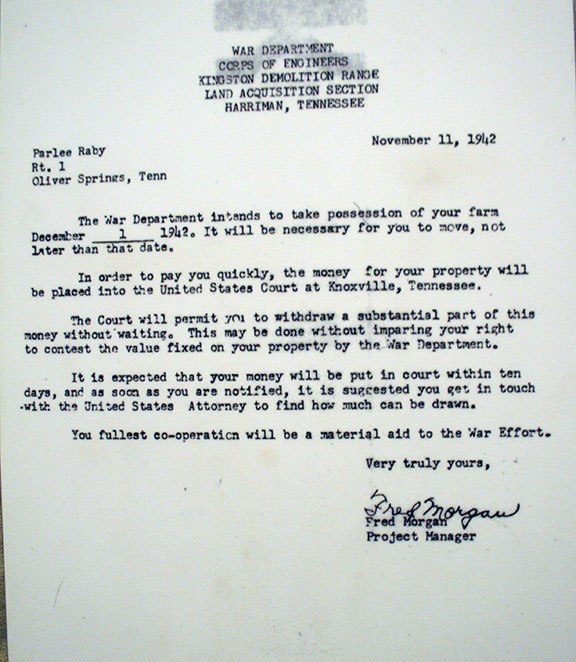
Three thousand persons among 1,000 families
living in the valley that became the Oak Ridge nuclear site had less
than a month to pack up and leave. While they could contest in
court the value of their property, they could not contest the US
government's taking of the land. This was the result of the War
Powers Act enacted by Congress which also was used to purchase land for
munitions, aircraft and other war related plants and facilities during
the war. Things were different then than they are today.
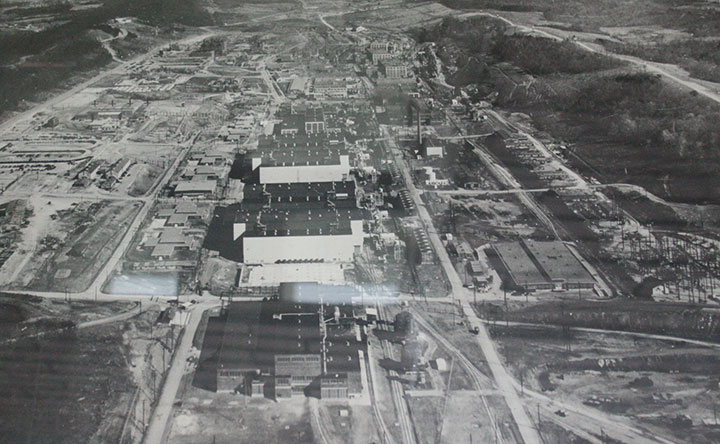
A small part of the complex.
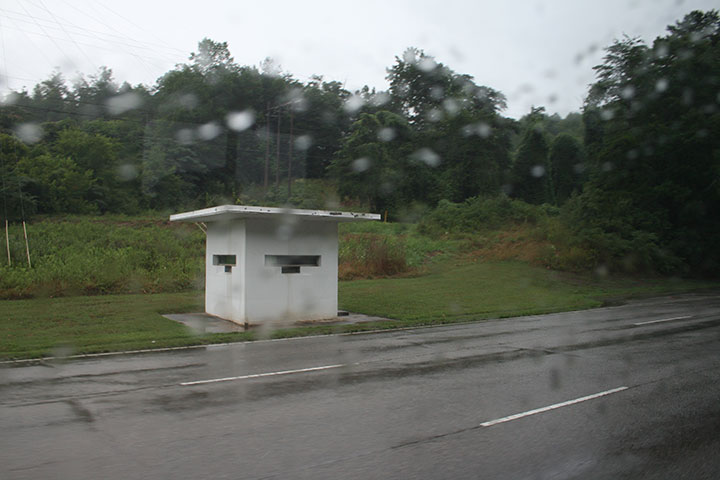
This is one of the original security gates from WWII as taken from the
tour I was on during a rainy day.
Today the Oak Ridge Facility is operated by the Department of Energy and
after 9-11 is not accessible to the public unless on a tour provided by
the American Museum of Science and Energy in Oak Ridge. The tour
only runs once a day and I believe only during the summer months.
The tour stops at X-10 Graphite Reactor and drives around what used to
be K-25, as it has been torn down. For the WWII historian it a
good tour. Y-12 is only accessible one day a year in June when the
town holds a festival. It is only open to US citizens as this is
the area that the DOE is storing all of the weapons grade uranium.
The tour may or may not be allowed in the future as July 28, 2012, two
weeks after I was there, three anti-war protesters were able to breach
all of the security and get to the building where the uranium is stored.
The one incidence should not affect the tour but sometimes officials
over react and punish the wrong people. One of the persons that
cut through the chain link fences and got past the security cameras that
weren't working was an 82 year old nun. So much for good security
when and 82 year old nun can do it!!. But the security of our
nuclear weapons stockpile is probably contracted out to the lowest
bidder of rent-a-cops, so what can you expect. You always get what
you pay for. Barney Fife with one bullet and a box of jelly
donuts.

This notice of eviction shows the human side of those being forced off
their land. Many had had the same thing happen to them 10 years
earlier when the TVA came in and built a dam in the area.
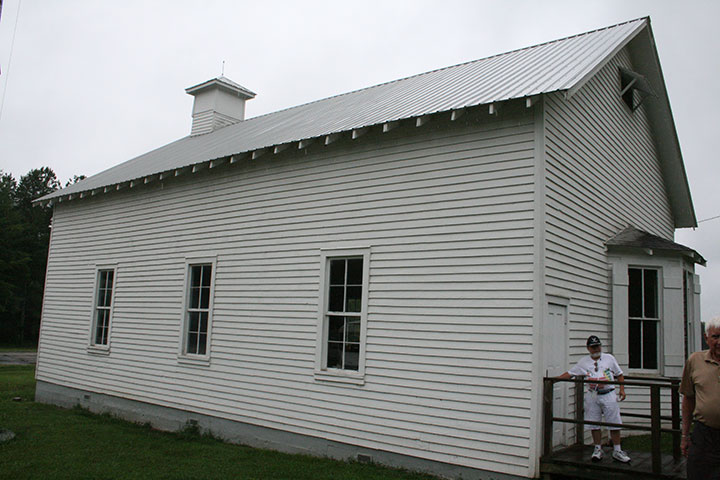
One of the stops is this church that has
been turned into a small museum where the above previous photo was
taken.
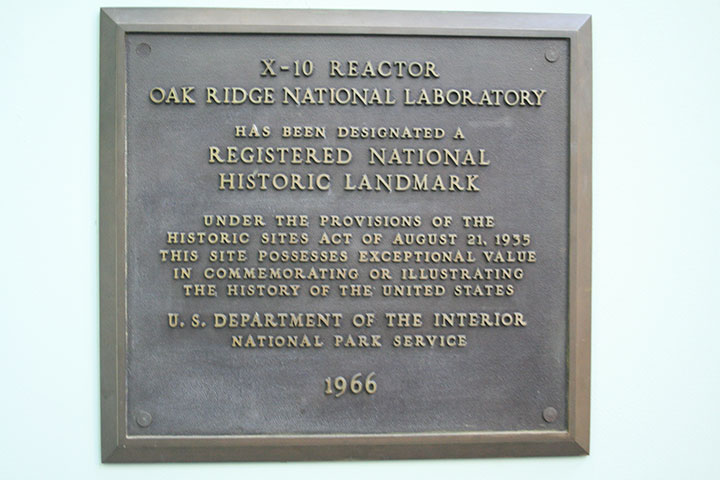
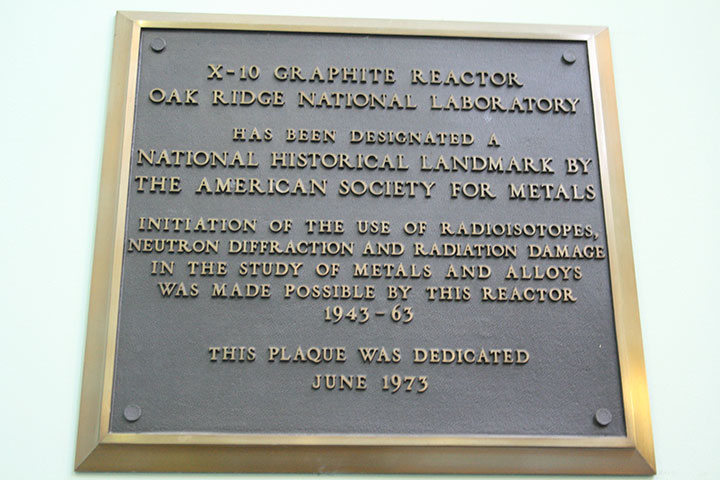
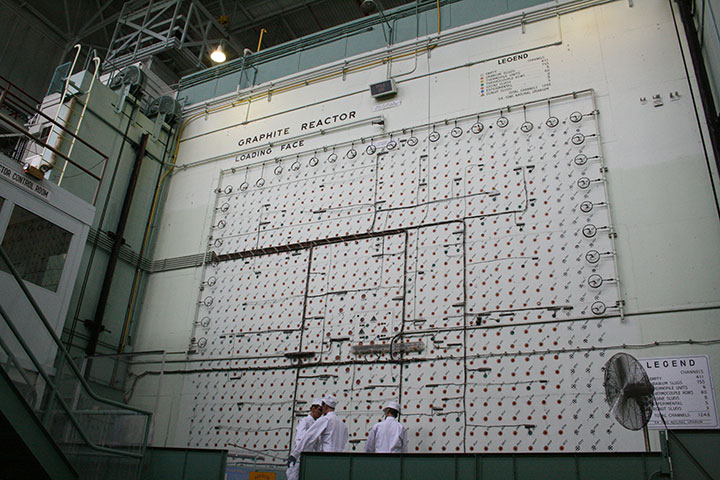
This is the front loading face of the X-10 Graphite Reactor at Oak
Ridge. The interesting thing is that back in the 1980's before
9-11 when security drastically increased I had driven to this location
with my family while on a vacation to Florida. Actually I am not
sure how I knew about it or found it as it is miles beyond the new
security gate and out in the middle of nowhere. Once the tour bus
turned up the road to the Reactor I remembered being here. Photos
were not allowed outside of the Reactor. The Reactor was the only
place I visited with the family as I was unaware of the American Museum
of Science and Energy until this trip in 2012. The Museum was open in
the 1980's when we came through here.
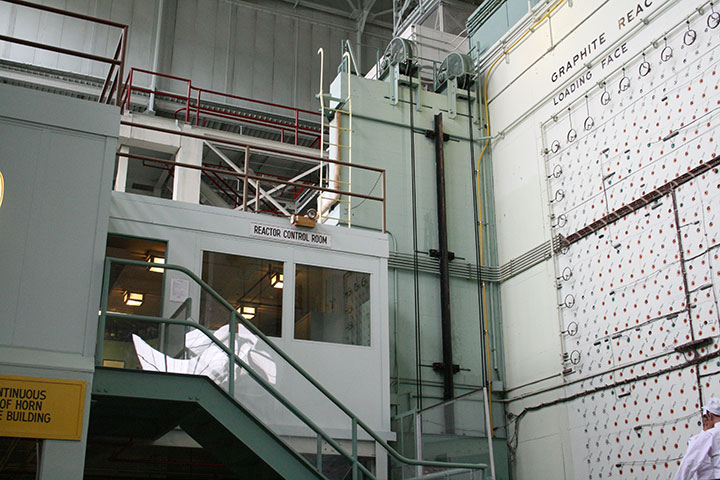
The control room from the outside.
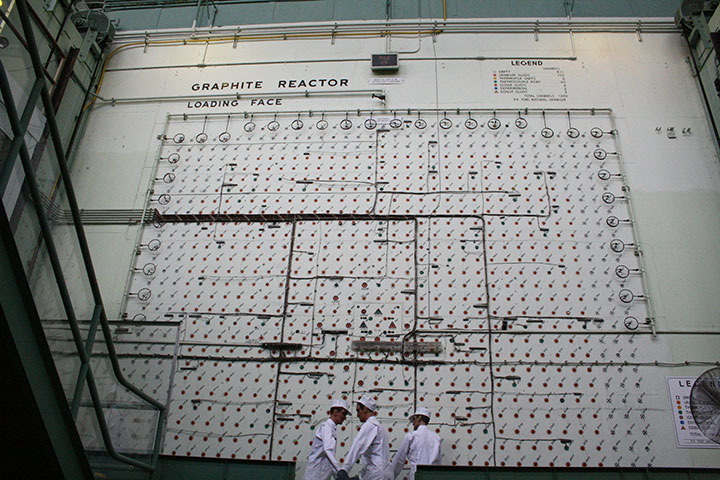
This is a historical location because it is the world's first production
nuclear reactor. We have to qualify the term "first" because the
world's first reactor was under the football stadium in a squash court
at the University of Chicago for proof of concept of a nuclear sustained
reaction on December 2, 1942.
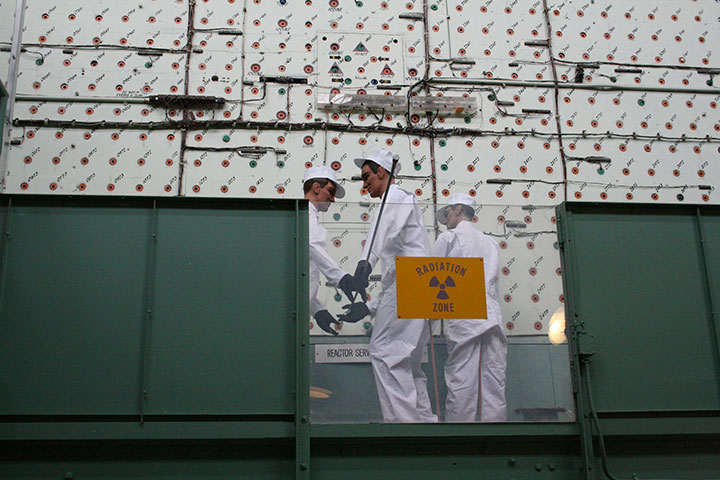
The operators are standing on an elevator which allowed them to access
all of the holes for insertion of Uranium and other materials.
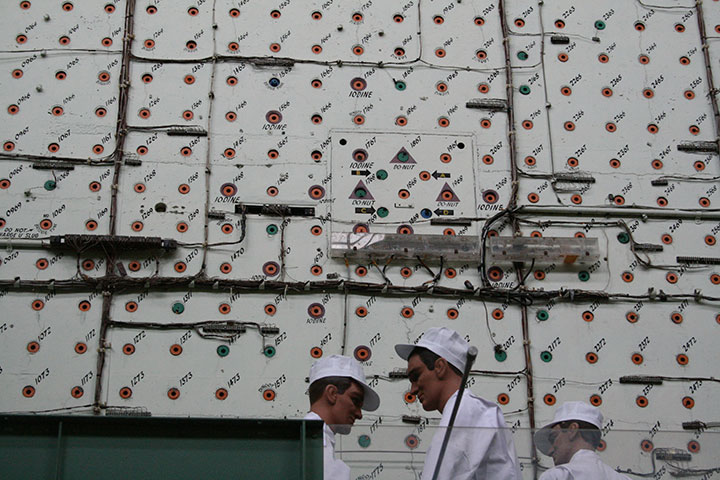
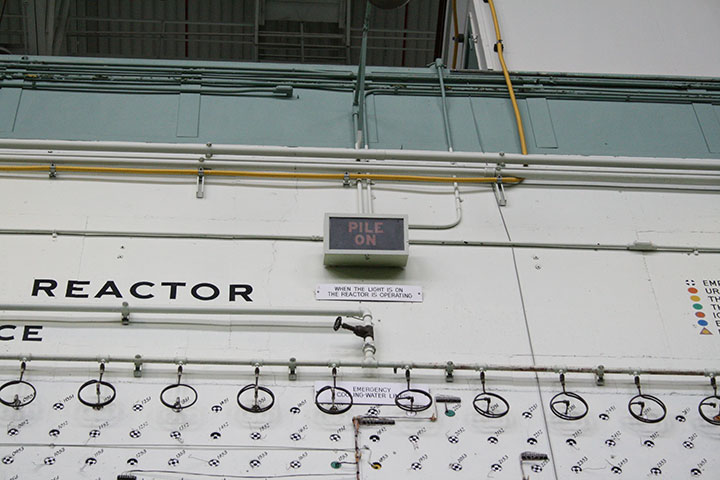
A simulated operation of the Reactor as it is now non functional.

The right side of the elevator and its guide to the top of the reactor
face.
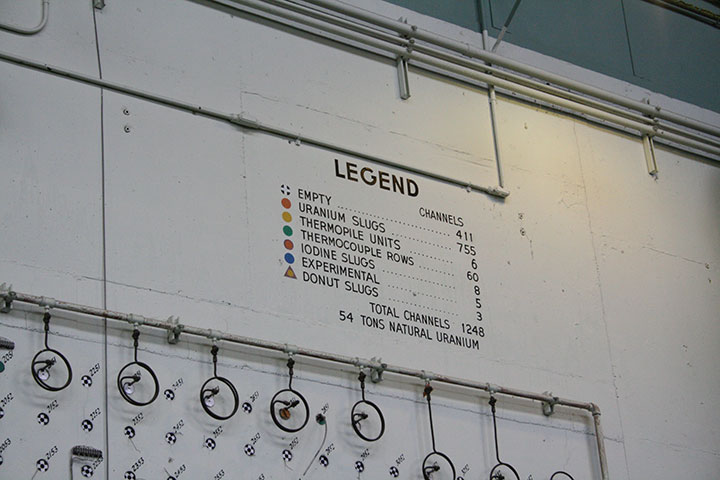
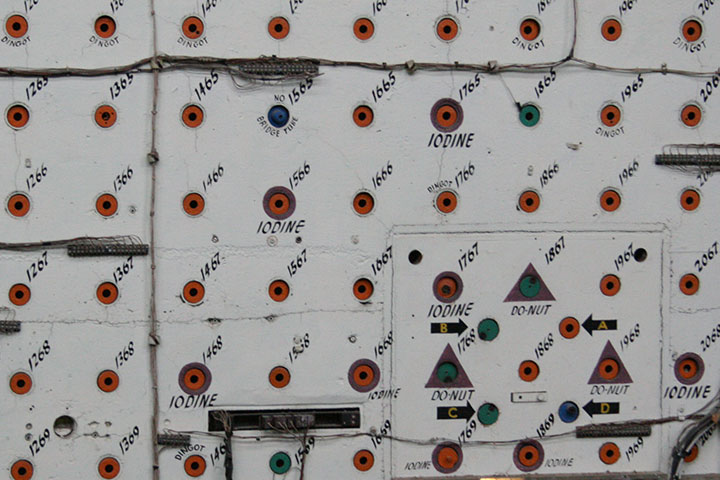
Remember the size and number of holes or channels on the front.
1,248 from the photo above.
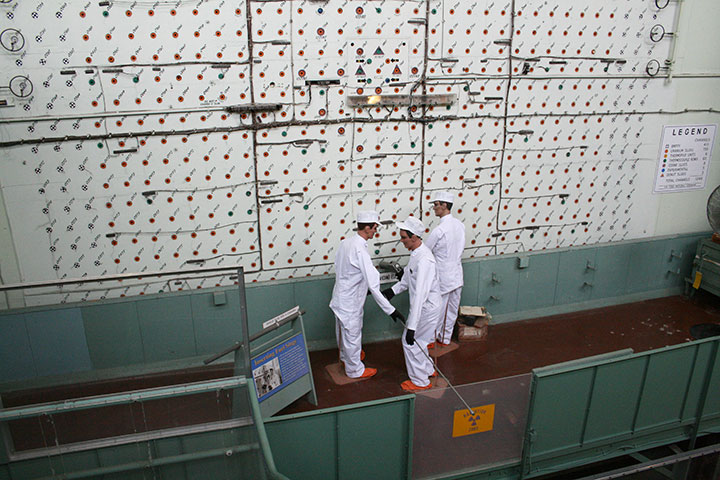
A view from the stairs leading to the control room. A later photo
will show the space behind the operators for the 35 foot rods that go
into the reactor.
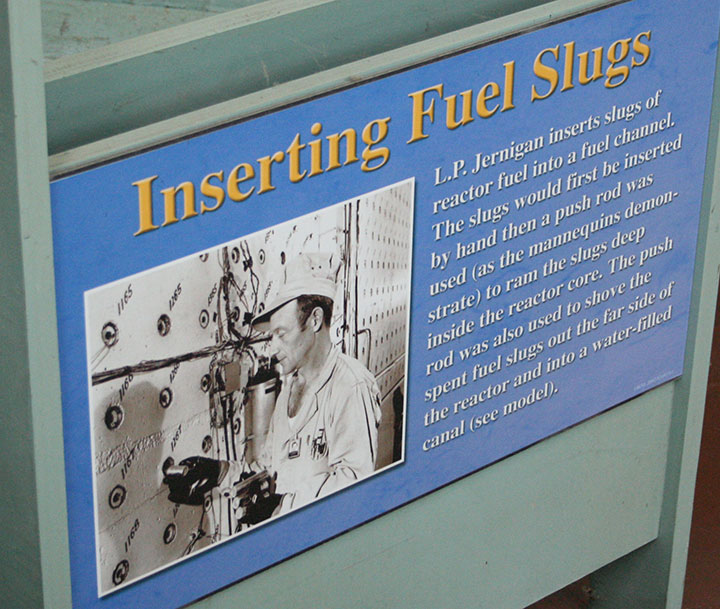
Mr. Jernigan would be inserting Uranium into
the Reactor. U-238 is not all that dangerous to handle in the
solid state. However, one does not want to ingest it in powder
form or get it on ones hand, hence the heavy rubber gloves. Once
the U-238 is in Reactor it can be bombarded with neutrons which then
creates more dangerous isotopes of uranium along with other nuclear
elements.
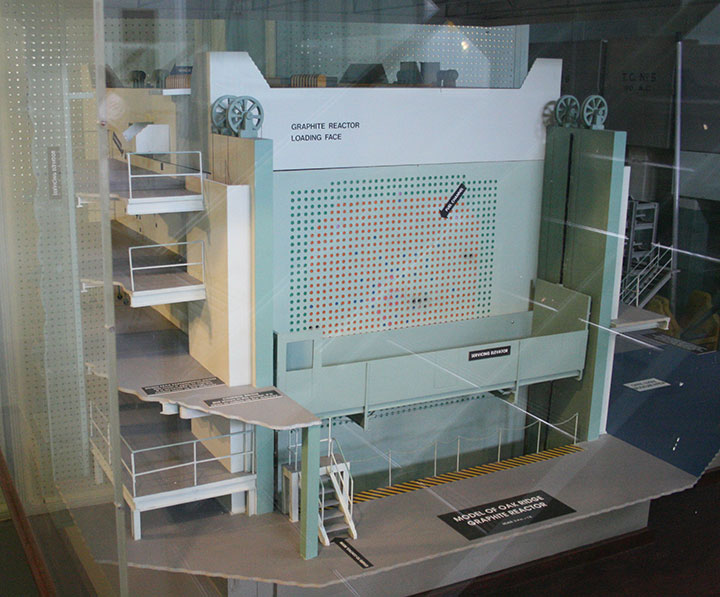
A model of the face of the reactor which shows the elevator at a higher
position.
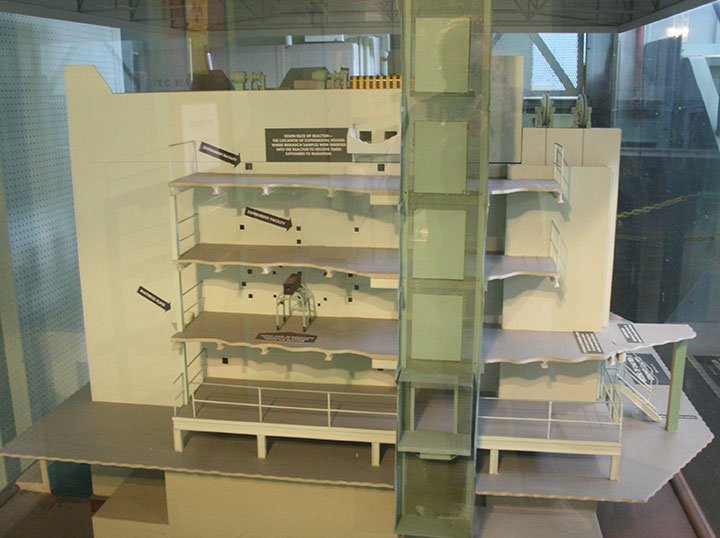
A side view of the model. The little stand on the second level is
where isotope samples could be removed from out of the reactor.
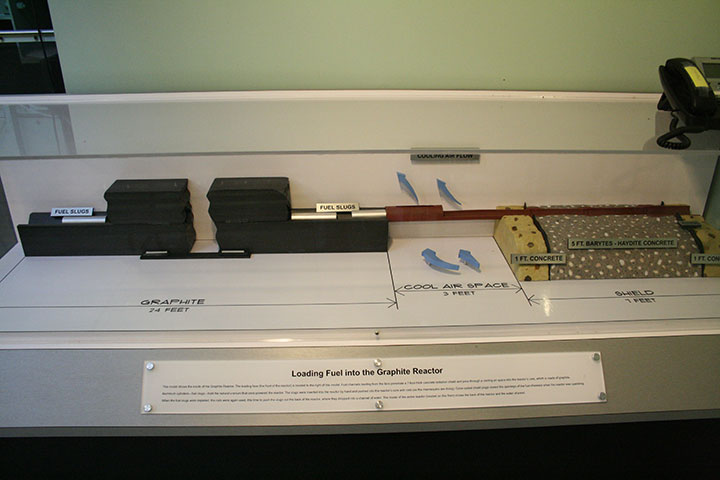
This model shows the internal cross section
of the X-10 reactor. Note that it is 34 feet in depth not
including the water tank for cooling at the left. There would have
had to have been 1,248 holes precision drilled through seven feet of
concrete just inside the operators face at the right, 1,248 guides to
carry the fuel slugs over the three feet of cool air space and then
another 1,248 precision holes drilled through the 24 feet of graphite,
which was constructed of graphite bricks. From the letters above
we know that the US Government started purchasing the land and hence
began construction of all of the facilities at Oak Ridge in late 1942
and early 1943 including this reactor. As you will see several
photos down the X-10 Reactor went critical (operational) on November
4th, 1943, less than a year after construction began and 11months after
the first reactor went critical at the University of Chicago.

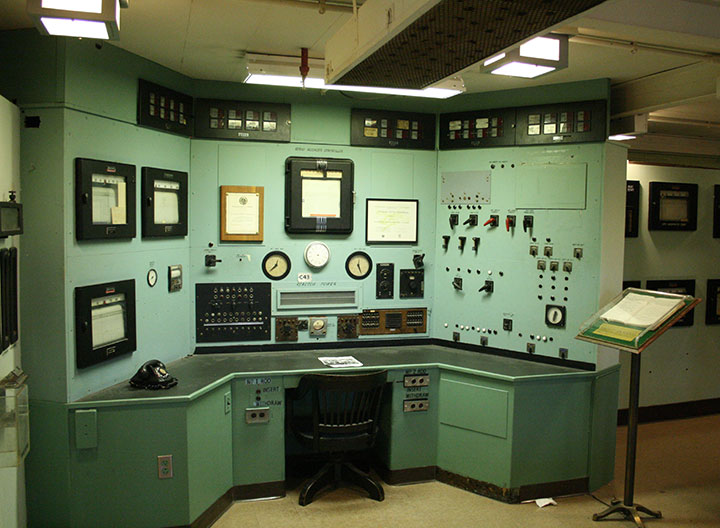
No computers here! Just analog gauges and strip recorders.

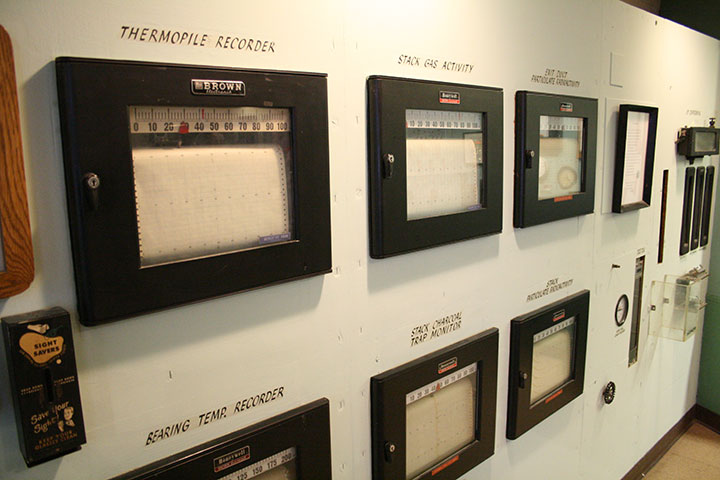
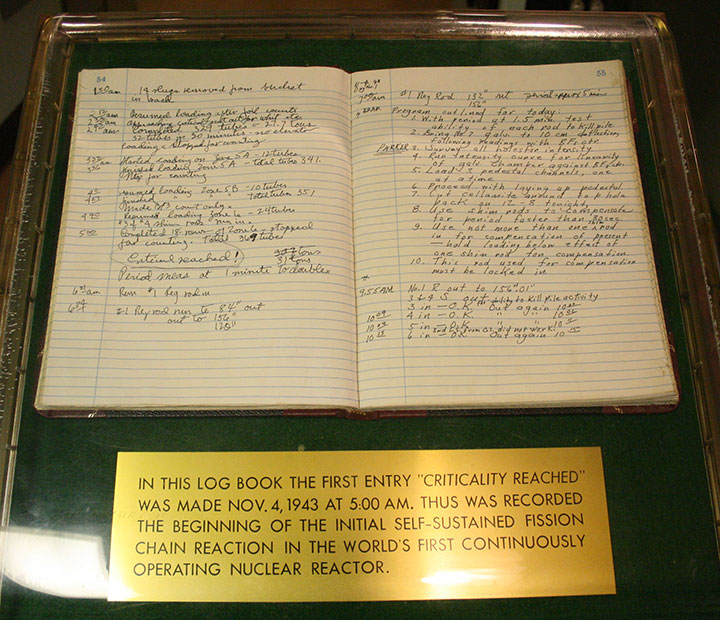
A simple log book recorded the time the reactor went critical.
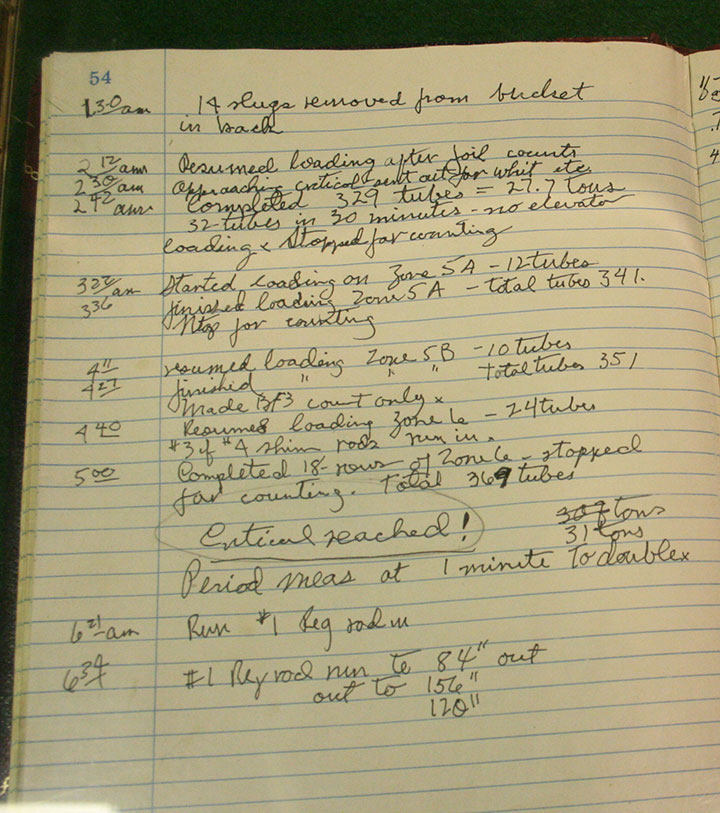
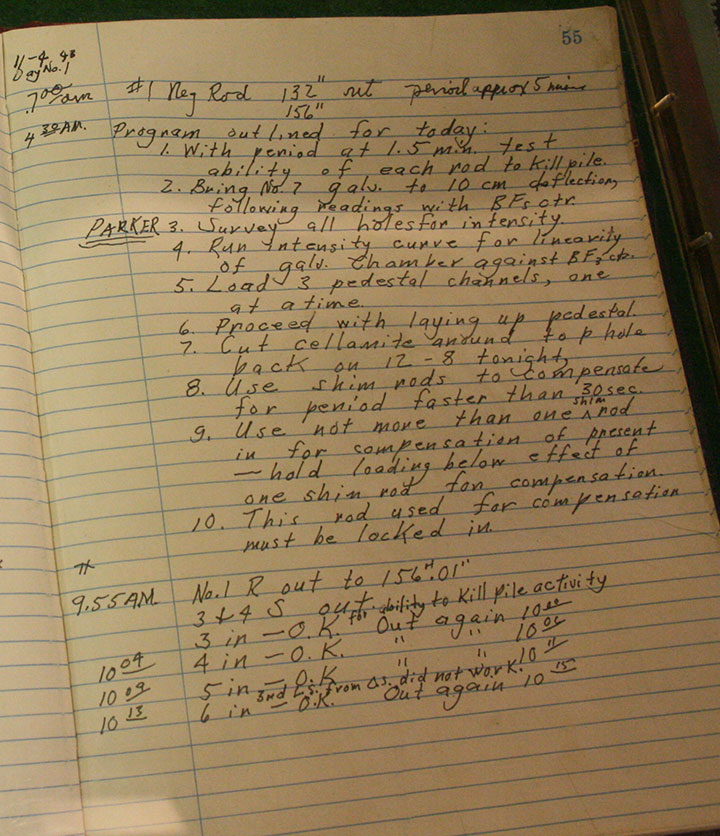

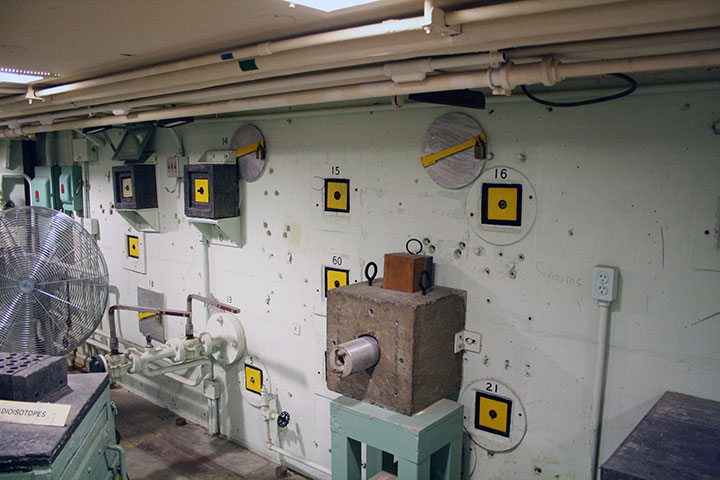
This is area along the side where isotopes came out of the reactor.
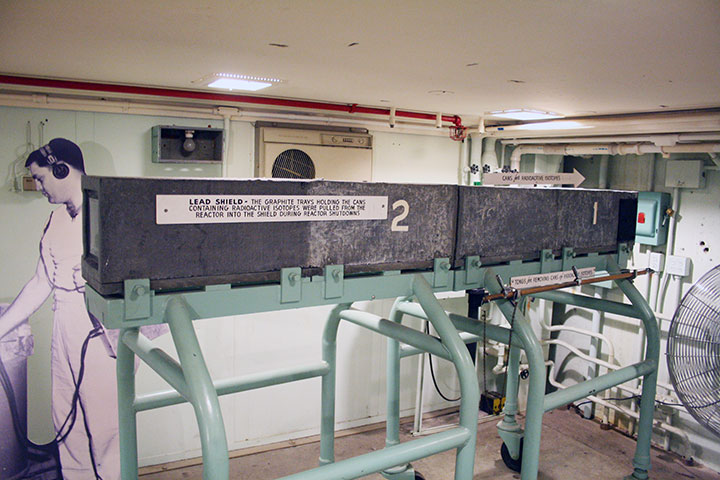
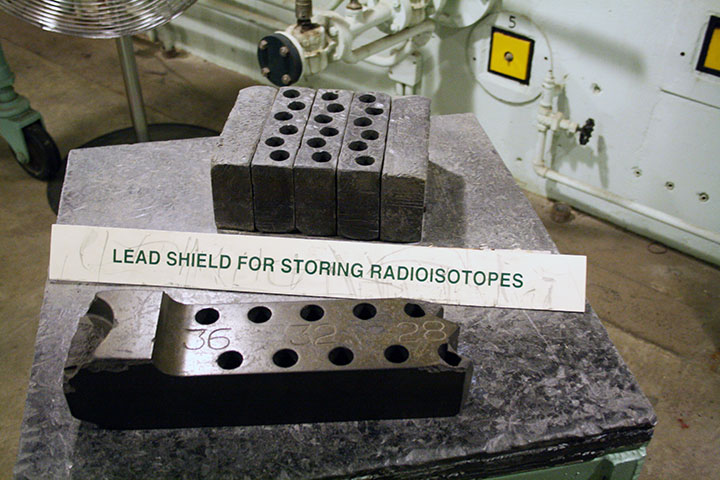
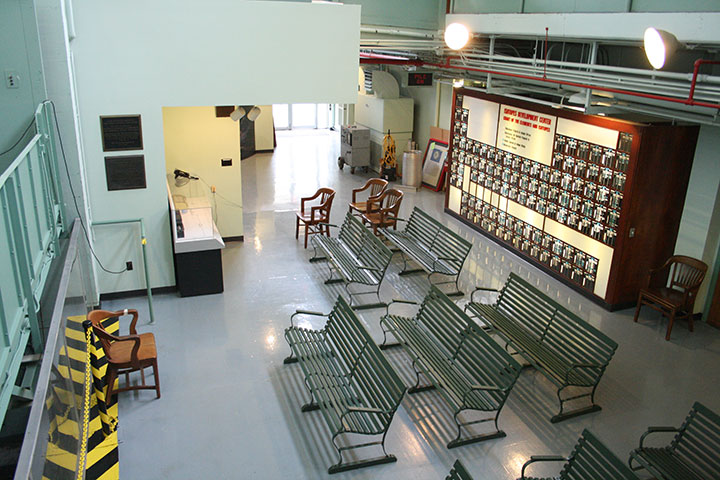
Looking down from the control room. I never really understood why
all this space was left open until I realized that the rods that pushed
the fuel slugs in would have to be at least 35 feet long and the open
space allows room for the rods when they are pulled back out.
During operation the seats would not be there. Today visitors sit
and listen to the tour guide as he give some history of the reactor
while he stands in front of the loading face.

The isotopes that were made for the first time right in this building.
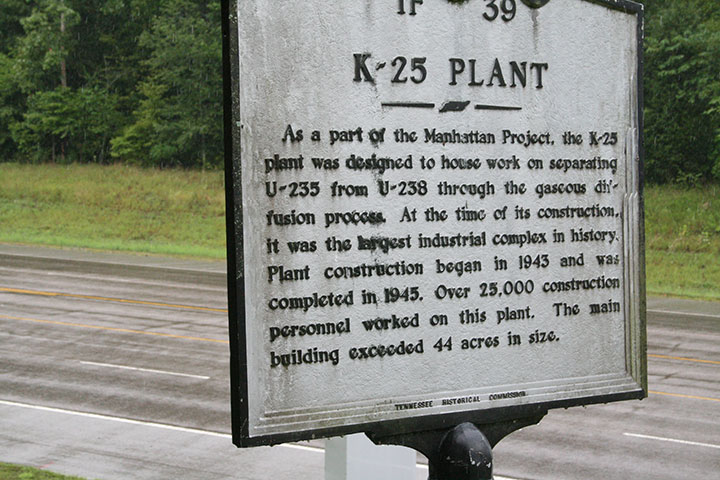
Next stop on the tour was an overlook of where the K-25 plant used to
be.
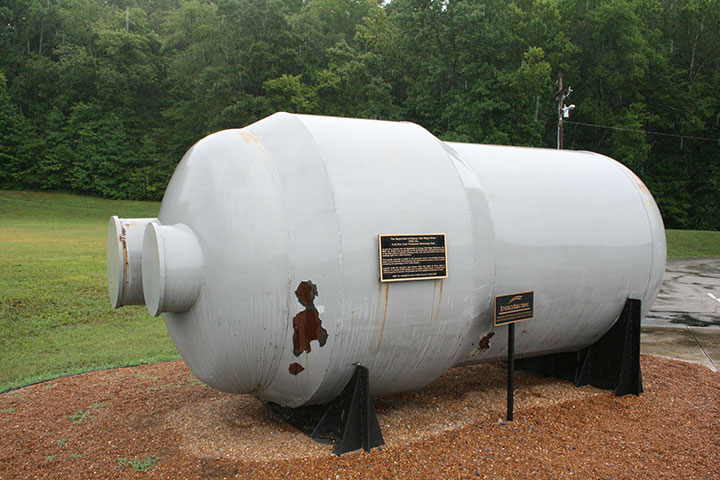
A converter from K-25.


The bus then takes a trip around where K-25 used to be. There is
really no good way to photograph where it was due to the distance.
What looks like a small clearing above the building with rounded roof is
the 44 acres of concrete where the building was located.
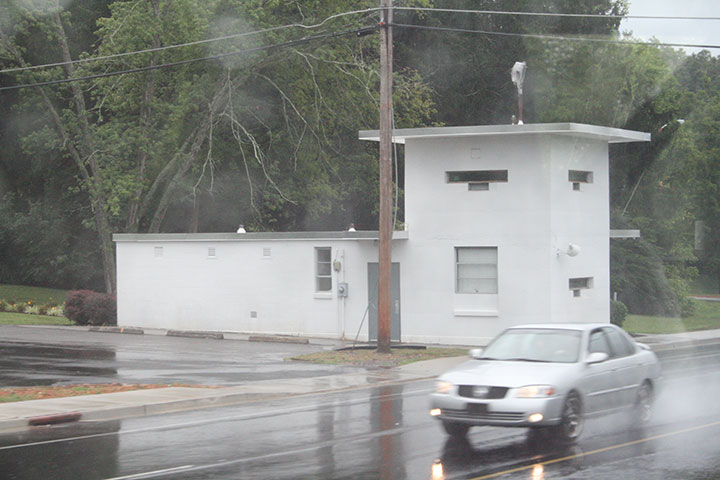
Another guard house as we left the area.
University of Chicago, IL
Oak Ridge, TN
Los Alamos, NM
Trinity Site, NM
|






































